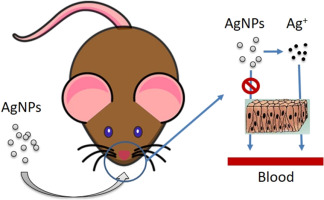Journal of Controlled Release ( IF 10.8 ) Pub Date : 2017-10-20 , DOI: 10.1016/j.jconrel.2017.10.018 Jonathan L. Falconer , David W. Grainger

|
Silver nanoparticles (AgNPs) are widely available as consumer goods, and over-the-counter or nutraceutical products used for alleged therapeutic and antibacterial properties. Among these products, AgNP topical therapy is proposed for treating patients with upper airway bacterial rhinosinusitis. While silver ion release from AgNPs in biological systems is well known, limited investigations actually characterize this silver ion release and their subsequent biological effects distinct from delivered particulate metallic silver. This is in part due to the analytical complexity and difficulty involved in distinguishing silver ion release from metallic AgNPs in biological media. Therefore, this study compared intranasal administration of AgNPs versus soluble silver ion (AgNO3) control to examine their transport and biological differences in tissues. First, we compared bactericidal activities of AgNPs and AgNO3 in those bacteria commonly associated with clinical rhinosinusitis in vitro. Next, we evaluated silver residence time in the sinus cavity after intranasal delivery of AgNPs and AgNO3 to mice, and characterized tissue distribution of silver in the sinonasal mucosal epithelium. We found that AgNPs show reduced bactericidal activity compared to AgNO3 (i.e., MBC of 15 ppm compared to 5 ppm), and significantly lower residence times in the sinus cavity (AgNP concentrations of 3.76 ppm after 3 h compared to 9 ppm for AgNO3). AgNPs were not readily taken up into or through respiratory epithelium, with very low silver levels found in blood and no detectable silver measured in the olfactory bulb and brain. Results indicate that limited tissue distribution of silver detected from AgNPs is due to AgNP dissolution to silver ion. AgNPs therefore demonstrate adequate safety through limited penetration and absorption, but limited potential therapeutic efficacy as antimicrobials in nasal applications, as concentrations of silver in the sinus cavity drop below the minimum bactericidal concentration within 3 h.
中文翻译:

小鼠鼻内给药后银纳米颗粒和银离子转运的体内比较
银纳米颗粒(AgNPs)可广泛用作消费品,以及用于所谓的治疗和抗菌特性的非处方或保健食品。在这些产品中,建议使用AgNP局部疗法来治疗上呼吸道细菌性鼻鼻窦炎患者。尽管在生物系统中从AgNPs释放银离子是众所周知的,但有限的研究实际上表征了这种银离子的释放及其随后的生物学效应,与所输送的颗粒金属银不同。部分原因是由于分析的复杂性和区分生物介质中金属AgNPs中的银离子释放所涉及的困难。因此,本研究比较了鼻内施用AgNPs与可溶性银离子(AgNO 3)对照以检查其在组织中的转运和生物学差异。首先,我们比较了在体外通常与临床鼻-鼻窦炎相关的细菌中AgNPs和AgNO 3的杀菌活性。接下来,我们评估了在鼻内递送AgNPs和AgNO 3给小鼠后银在鼻窦腔中的停留时间,并表征了银在鼻窦粘膜上皮中的组织分布。我们发现与AgNO 3相比,AgNPs表现出降低的杀菌活性(即MBC为15 ppm,而5 ppm则为MBC),并且在窦腔中的停留时间显着降低(3小时后的AgNP浓度为3.76 ppm,而AgNO 3为9 ppm。)。AgNPs不容易吸收到呼吸道上皮中或通过呼吸道上皮吸收,血液中的银含量非常低,嗅球和大脑中没有检测到可检测到的银。结果表明,从AgNP中检测到的银组织分布有限是由于AgNP溶解到银离子中。因此,AgNPs通过有限的渗透和吸收表现出足够的安全性,但由于鼻腔中银的浓度在3小时内降至最低杀菌浓度以下,因此在鼻部应用中作为抗菌剂的潜在治疗效果有限。

























 京公网安备 11010802027423号
京公网安备 11010802027423号